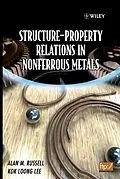This junior/senior textbook presents fundamental concepts of
structure property relations and a description of how these
concpets apply to every metallic element except iron.
Part One of the book describes general concepts of crystal
structure, microstructure and related factors on the mechanical,
thermal, magnetic and electronic properties of nonferrous metals,
intermetallic compounds and metal matrix composites.
Part Two discusses all the nonferrous metallic elements from two
perspectives: First it explains how the concepts presented in Part
One define the properties of a particular metallic element and its
alloys. Second is a description of the major engineering uses of
each metal. This section features sidebar pieces describing
particular physical property oddities, engineering applications and
case studies. An Instructor's Manual presenting detailed solutions
to all the problems in the book is available from the Wiley
editorial department.
An Instructor's Manual presenting detailed solutions to all the
problems in the book is available from the Wiley editorial
department.
Autorentext
ALAN M. RUSSELL, PHD, is a faculty member in the Materials Science and Engineering Department at Iowa State University in Ames, Iowa.
KOK LOONG LEE, PHD, is a materials technologist with Corus Construction & Industrial in North Lincolnshire, UK.
Klappentext
A long-awaited text that fills the void in non-ferrous metallurgy literature
While most undergraduate metallurgy textbooks focus on iron, the most commercially important metallic element, Structure-Property Relations in Nonferrous Metals is a comprehensive textbook covering the remaining eighty-two nonferrous metals. Designed to be readily accessible to materials engineering students at all academic levels, the text describes the relationships between the atomic-, crystal-, and micro-structures of nonferrous metals, and such physical behaviors as strength, ductility, electrical conductivity, and corrosion.
In order to capture and retain students' interest, the authors maintain a strong focus on practical application. Each chapter supplements fundamental concepts with engaging examples from actual engineering case studies and industrial projects, directly relating content to real-world application.
Part One describes the general concepts of crystal- and micro-structures and the implications of these structures for the mechanical, thermal, and electronic properties of nonferrous metals, intermetallic compounds, and metal matrix composites.
Chapters focus on such relevant topics as:
- Point, line, and planar defects and their effects on a material's properties
- Dislocations and strengthening mechanisms
- Fracture and fatigue
- Strain rate effects and creep
- Deviations from classic crystallinity
- Processing methods
- Composites and intermetallic compounds
Part Two builds on Part One by exploring how the concepts presented define the properties of a particular metallic element and its alloys, and how these properties contribute to the engineering uses of each nonferrous metal.
An accompanying ftp site contains homework problems, appendices, bibliographies, and tables of data indicating the nations producing metallic elements and the quantities produced. Structure-Property Relations in Nonferrous Metals is a valuable reference for both students in undergraduate metallurgy courses and practicing engineers.
Zusammenfassung
This junior/senior textbook presents fundamental concepts of structure property relations and a description of how these concpets apply to every metallic element except iron.
Part One of the book describes general concepts of crystal structure, microstructure and related factors on the mechanical, thermal, magnetic and electronic properties of nonferrous metals, intermetallic compounds and metal matrix composites.
Part Two discusses all the nonferrous metallic elements from two perspectives: First it explains how the concepts presented in Part One define the properties of a particular metallic element and its alloys. Second is a description of the major engineering uses of each metal. This section features sidebar pieces describing particular physical property oddities, engineering applications and case studies. An Instructor's Manual presenting detailed solutions to all the problems in the book is available from the Wiley editorial department.
An Instructor's Manual presenting detailed solutions to all the problems in the book is available from the Wiley editorial department.
Inhalt
Preface.
PART ONE.
1. Crystal and Electronic Structure of Meals.
1.1 Introduction.
1.2 Crystal Structures of the Metallic Elements.
1.3 Exceptions to the Rule of the Metallic Bond.
1.4 Effects of High Pressure on Crystal Structure.
1.5 Effect of Electronic Structure on Crystal Structure.
1.6 Periodic Trends in Material Properties.
2. Defects and their Effects on Materials Properties.
2.1 Introduction.
2.2 Point Defects.
2.3 Line Defects (Dislocations).
2.4 Planar Defects.
2.5 Volume Defects.
3. Strengthening Mechanisms.
3.1 Introduction.
3.2 Grain Boundary Strengthening.
3.3 Strain Hardening.
3.4 Solid-Solution Hardening.
3.5 Precipitation Hardening (or Age Hardening).
4. Disclocations.
4.1 Introduction.
4.2 Forces on Dislocations.
4.3 Forces Between Dislocations.
4.4 Multiplication of Dislocations.
4.5 Partial Dislocations.
4.6 Slip Systems in Various Crystals.
4.7 Strain Hardening of Single Crystals.
4.8 Thermally Activated Dislocation Motion.
4.9 Interactions of Solute Atoms with Dislocations.
4.10 Dislocation Pile-ups.
5. Fracture and Fatigue.
5.1 Introduction.
5.2 Fundamentals of Fracture.
5.3 Metal Fatigue.
6. Strain Rate Effects and Creep.
6.1 Introduction.
6.2 Yield Point Phenomenon and Strain Aging.
6.3 Ultrarapid Strain Phenomena.
6.4 Creep.
6.5 Deformation Mechanism Maps.
6.6 Superplasticity.
7. Deviations from Classic Crystallinity.
7.1 Introduction.
7.2 Nanocrystalline Metals.
7.3 Amorphous Metals.
7.4 Quasicrystalline Metals.
7.5 Radiation Damage in Metals.
8. Processing Methods.
8.1 Introduction.
8.2 Casting.
8.3 Powder Metallurgy.
8.4 Forming and Shaping.
8.5 Material Removal.
8.6 Joining.
8.7 Surface Modification.
9. Composites.
9.1 Introduction.
9.2 Composite Materials.
9.3 Metal Matrix Composites.
9.4 Manufacturing MMCs.
9.5 Mechanical Properties and Strengthening Mechanisms in MMCs.
9.6 Internal Stresses.
9.7 Stress Relaxation.
9.8 High-Temperature Behavior of MMCs.
PART TWO.
10. Li, Na, K, Rb, Cs, and Fr.
10.1 Overview.
10.2 History, Properties, and Applications.
10.3 Sources.
10.4 StructureProperty Relations.
11. Be, Mg, Ca, Sr, Ba, and Ra.
11.1 Overview.
11.2 History and Properties.
11.3 Beryllium.
11.4 Magnesium.
11.5 Heavier Alkaline Metals.
12. Ti, Zr, and Hf.
12.1 Overview.
12.2 Titanium.
12.3 Zirconium.
12.4 Hafnium.
13. V, Nb, and Ta.
13.1 Overview.
13.2 History and Properties.
13.3 Vanadium.
13.4 Niobium.
13.5 Tantalum.
14. Cr, Mo, and W.
14.1 Overview.
14.2 Chromium.
14.3 Molybdenum.
14.4 Tungsten.
15. Mn, Tc, and Re.
15.1 Overview.
15.2 Hi…
